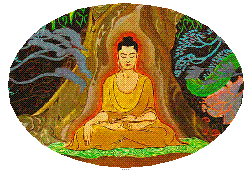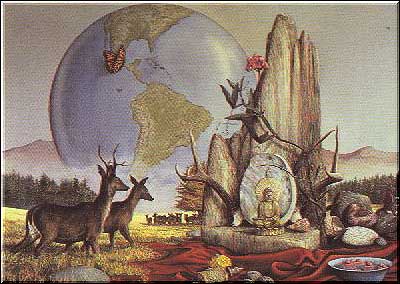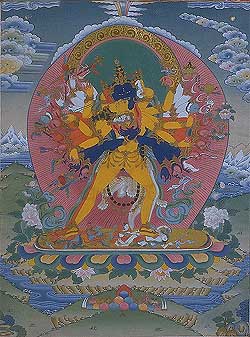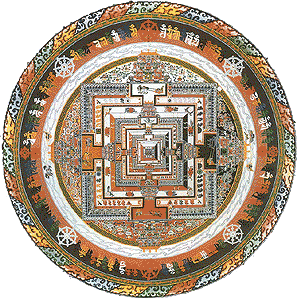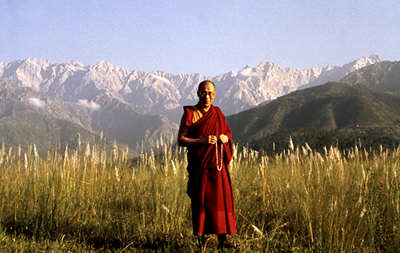
|
|
 |
Tibetan Buddhism |
 |
Tibetan Buddhism stems from the influence of two major sources, Buddhism and yoga. Initially brought to Tibet by Padmasambhava in the 8th Century, Tibetan Buddhism incorporates both Hindu yogic and Tantra practices as well as the classical teachings of The Buddha. It concentrates on the removal of suffering from all beings, with the understanding that no one person can alleviate individual suffering until all other beings have been liberated from it as well. The path of traditional Buddhism is based on morality, concentration, wisdom, and denunciation of the personal ego. The second path, the Tantric path, is the cornerstone of Tibetan Buddhism, blending the Buddhist sutra (sacred text) teachings with those of the Hindu yoga and Tantra.
|
|
||
|
The Tantric path seeks to transform basic human passions of desire and aversion into spiritual growth and development. Thus, instead of denying primal sexual and sensual urges as in traditional Buddhism, the practice of Tantra accepts these urges as sacred life force energy, which is purified and transformed into wholesome and healthy forces connecting the individual with higher spiritual awareness. In order to be successful with Tantric work, one must have skill in both self-control and acceptance of self and others.
Tibetan Tantra, also known as Vajrayana, draws on the core teachings of both Mahayana and Hinayana, two schools of Buddhism. Mahayana Buddhism emphasizes the help that the gods and the bodhisattvas can give to people to help them escape samsara, the continual cycle of death and rebirth. Mahayana doctrines teach selflessness, the bodhisattva stages, perfections and prayers to achieve perfect alignment for the sake of all sentient beings. Hinayana, sometimes called “the little
way," emphasizes personal emancipation rather than being concerned with the burdens of others. While those who practice Hinayana initially do not do so with the intent of obtaining Buddhahood, eventually this path too may lead to Mahayana and enlightenment. |
||
|
|
||
|
Mahayana is made up of two vehicles, the Paramitayana and the Mantrayana. Paramitayana is a “Cause vehicle” in which there is no meditation on oneself in regard to the four complete purities of abode, body, property and activities, representative of a
Buddha’s palace, body, wealth and deeds. Mantrayana is the “Effect vehicle,” in which there
is meditation on oneself as being a physical representation of the four complete purities. In Mantrayana, therefore, one meditates on oneself as being a divine mansion, a divine entourage, divine ritual implements, and the divine deeds of purifying the cosmos and its inhabitants in the same manner as a Buddha. There are four types of Mantrayana: inferior, middling, superior, and most excellent. These four classes of Tantra are designed to meet the needs of four types of disciples. The four classes are similar to “four doors”: Ritual Tantra, Conduct Tantra, Yoga Tantra, and Unexcelled Yoga Tantra. The Kalachakra belongs to the Unexcelled Yoga Tantra class. |
||
|
|
||
|
Kalachakra: Wheel of Time |
||
| For more than 2,500 years, the Kalachakra teachings have been preserved in India and Tibet. Kalachakra Tantra comprises the innermost essence of the 84,000 categories of the teachings of The Buddha. Its major purpose is to assist us in purifying our body, speech and mind. There is a special connection between Kalachakra and the land of Shambhala in regard to a future golden age of Dharma. It carries a profound message for the all the people on Earth at this time in history. |
||
|
|
|
|
|
The three levels of the Kalachakra Tantra are known as external, internal and alternative, each of which is a wheel of time. The external or outer Wheel of Time concerns laws of time and space of our three dimensional, physical world and deals with astronomy, astrology and mathematics. It is also called “The procession of the external solar and lunar days.” The internal Wheel of Time is concerned with the human body, including its energy system. The alternative Wheel of Time includes the doctrine, path and initiations of Shri Kalachakra, its circular
Mandala abode, and its results. The disciple who takes the Kalachakra initiations should have knowledge of the three principle aspects of the Mahayana path: renunciation of samsara (continuing cycle of death and rebirth), bodhichitta, and an understanding of emptiness. “Bodhichitta is the desire for true, perfect enlightenment for the sake of others.” |
||
|
The Kalachakra Mandala |
||
|
|
||
|
The Tibetan word for Mandala is “kilkhor,” meaning “center of the circle.” Mandalas may incorporate colored sand, jewels, flowers, colored stones, or dyed rice. As each grain of sand in the Mandala is charged with the blessings of the ritual purpose and process, the entire Mandala carries an incredible spiritual energy. Each Mandala is a sacred mansion of its own. Both the deity residing at the center of the Mandala and the Mandala in its entirety are perceived as sacred expressions of the enlightened mind of The Buddha. Each person engaging in the initiation ceremony is nourished through the process of visualizing and contemplating the Mandala. There are 722 deities in the Kalachakra Mandala, symbolizing various manifestations of consciousness and reality. The Dalai Lama has explained that the Kalachakra deities represented in the Mandala create a favorable atmosphere that reduces tension and violence in the world. |
||
|
|
||
|
The Kalachakra deity resides in the center of the Mandala in his palace consisting of four
Mandalas, one within the other: the Mandalas of body, speech, and mind, and in the very center, wisdom and great bliss. The palace is divided into four quadrants, each with walls, gates and a center and a specific color. The colors represent the elements and mental types. Black in the east is associated with the element of air and wind. The south is red, representing the element of fire. The west is yellow and associated with the element of earth. The north is white, representing the element of water. The square palace containing the 722 deities is located on the concentric circle representing Earth. The other circles representing water, fire, wind, space and consciousness extend beyond the wall of the palace. The Kalachakra sand Mandala is dedicated to both individual and world peace and physical balance. The Dalai Lama explains: “It is a way of planting a seed, and the seed will have karmic effect. One doesn’t need to be present at the Kalachakra ceremony in order to receive its benefits.” |
||
|
|
||
|
Copyright 1999 - 2022 All rights reserved |
||
|
|
